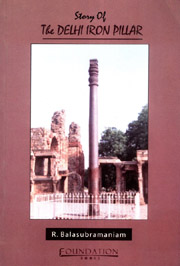3 - Structural Features of the Pillar
Published online by Cambridge University Press: 26 October 2011
Summary
In this chapter, we shall address various aspects related to the structural features of the Delhi Iron Pillar. The nature of the portion of the pillar that is buried will be studied first. A detailed analysis of the dimensions of the pillar provides proof of the engineering, planning and skill of the craftsmen who conceived and manufactured it. There are some areas on the pillar where the presence of lead has been confirmed and these areas will be briefly described. The artistic and engineering aspects of the decorative bell capital will be described in the end.
The Buried Part of the Pillar
When we look at the Iron Pillar as it stands in the courtyard of the mosque, we notice that the bottom region of the pillar has a very rough and uneven surface. There are visible hammer marks in this area. This is in marked contrast to the region just above the rough region, which appears extremely smooth and polished. In order to understand these features, take a look at PLATE 7. Let us now look more carefully at this rough bottom region (PLATE 8).
The original engineers deliberately made the bottom of the pillar rough so that the pillar would have a better grip when it was erected. This region was to remain buried underground and was not intended to be exposed. There is sufficient evidence to conclude that the rough part of the pillar, which is now visible above ground level, was originally buried while it was located at Udayagiri.
- Type
- Chapter
- Information
- Story of the Delhi Iron Pillar , pp. 29 - 45Publisher: Foundation BooksPrint publication year: 2005

